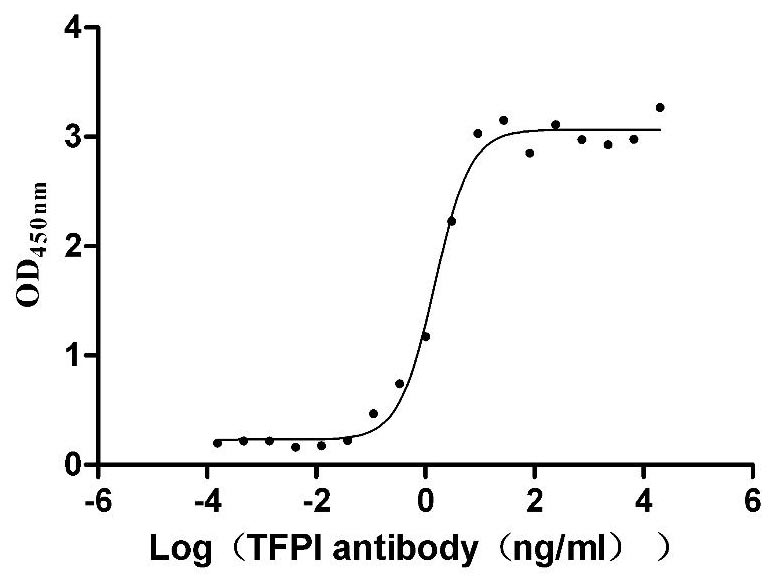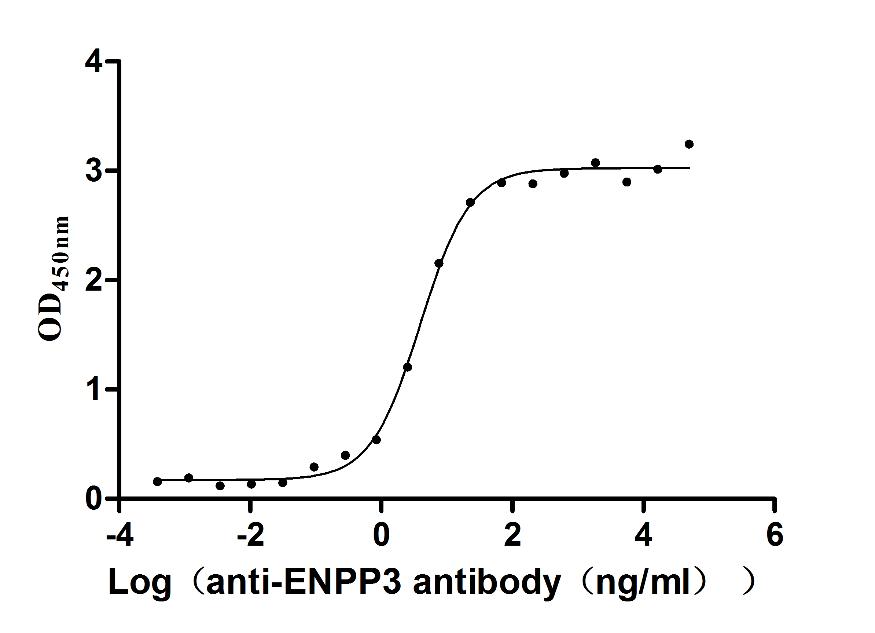Recombinant Human Leukocyte cell-derived chemotaxin 1 (LECT1)
-
货号:CSB-CF012854HU
-
规格:
-
来源:in vitro E.coli expression system
-
其他:
产品详情
-
基因名:CNMD
-
Uniprot No.:
-
别名:BRICD3; BRICHOS domain containing 3; CH-SP; CHM I; ChM-I; CHM1; chondromodulin; Chondromodulin I; Chondromodulin-1; Chondromodulin-I; Chondrosurfactant protein; LECT 1; Lect1; LECT1_HUMAN; Leukocyte cell derived chemotaxin 1; Multiple myeloma tumor suppressor 1; MYETS1
-
种属:Homo sapiens (Human)
-
蛋白长度:full length protein
-
表达区域:1-210
-
氨基酸序列MTENSDKVPIALVGPDDVEFCSPPAYATLTVKPSSPARLLKVGAVVLISGAVLLLFGAIGAFYFWKGSDSHIYNVHYTMSINGKLQDGSMEIDAGNNLETFKMGSGAEEAIAVNDFQNGITGIRFAGGEKCYIKAQVKARIPEVGAVTKQSISSKLEGKIMPVKYEENSLIWVAVDQPVKDNSFLSSKVLELCGDLPIFWLKPTYPKEIQ
Note: The complete sequence including tag sequence, target protein sequence and linker sequence could be provided upon request. -
蛋白标签:10xHis-SUMO-tag
-
产品提供形式:Liquid or Lyophilized powder
Note: We will preferentially ship the format that we have in stock, however, if you have any special requirement for the format, please remark your requirement when placing the order, we will prepare according to your demand. -
缓冲液:Lyophilized from Tris/PBS-based buffer, 6% Trehalose, pH 8.0
-
储存条件:Store at -20°C/-80°C upon receipt, aliquoting is necessary for mutiple use. Avoid repeated freeze-thaw cycles.
-
保质期:The shelf life is related to many factors, storage state, buffer ingredients, storage temperature and the stability of the protein itself.
Generally, the shelf life of liquid form is 6 months at -20°C/-80°C. The shelf life of lyophilized form is 12 months at -20°C/-80°C. -
货期:Basically, we can dispatch the products out in 1-3 working days after receiving your orders. Delivery time may differ from different purchasing way or location, please kindly consult your local distributors for specific delivery time.Note: All of our proteins are default shipped with normal blue ice packs, if you request to ship with dry ice, please communicate with us in advance and extra fees will be charged.
-
注意事项:Repeated freezing and thawing is not recommended. Store working aliquots at 4°C for up to one week.
-
Datasheet & COA:Please contact us to get it.
相关产品
靶点详情
-
功能:Bifunctional growth regulator that stimulates the growth of cultured chondrocytes in the presence of basic fibroblast growth factor (FGF) but inhibits the growth of cultured vascular endothelial cells. May contribute to the rapid growth of cartilage and vascular invasion prior to the replacement of cartilage by bone during endochondral bone development. Inhibits in vitro tube formation and mobilization of endothelial cells. Plays a role as antiangiogenic factor in cardiac valves to suppress neovascularization.
-
基因功能参考文献:
- ChMI directly suppressed the proliferation and growth of osteosarcoma cells. PMID: 28983591
- CHM1 seems to have pleiotropic functions in Ewing sarcoma. PMID: 28319320
- The results of the present study indicated that ChMI was able to inhibit the growth of breast cancer cells; thus suggesting that ChM-I may have potential clinical applications in the treatment of breast cancer. PMID: 27035228
- Data suggest ChM1 as potential tumor suppressor in gastric cancer and useful biomarker for the treatment and prognosis. Its expression was downregulated in cancer tissue, and correlated with advanced stages, lymph node metastasis, and poorer prognosis. PMID: 26165347
- intact 20-25 kDa ChM-I is stored as a component of extracellular matrix in the avascular cartilage zones, but it is inactivated by a single N-terminal proteolytic cleavage in the hypertrophic zone of growth-plate cartilage PMID: 24710035
- the inner meniscus contained larger amounts of ChM-I, and that the inner meniscus-derived ChM-I inhibited endothelial cell proliferation. PMID: 23143879
- Degenerative intervertebral disc cells express ChM-I. Administration of bFGF down-regulates the expression of ChM-I. Expression is correlated with the degree of degeneration. PMID: 22041680
- Inhibition of YY1 in combination with forced expression of p300 and Sp3 restored the expression of ChM-I in cells with a hypomethylated promoter region, but not in cells with hypermethylation. PMID: 20663886
- Data suggest that chondromodulin-I impairs the VEGF-A-stimulated motility of endothelial cells by destabilizing lamellipodial extensions. PMID: 20026108
- Methylation in the core-promoter region of the chondromodulin-I gene determines the cell-specific expression by regulating the binding of transcriptional activator Sp3 PMID: 15107420
- chondromodulin-I has a pivotal role in maintaining valvular normal function by preventing angiogenesis that may lead to valvular heart diseases PMID: 16980969
- Cell-specific epigenetic regulation of ChM-I gene expression PMID: 17980151
- new hypoxia-inducible and SOX9-regulated genes, Gdf10 and Chm-I. In addition, Mig6 and InhbA were induced by hypoxia, predominantly via HIF-2alpha PMID: 18077449
显示更多
收起更多
-
亚细胞定位:[Chondromodulin-1]: Secreted, extracellular space, extracellular matrix. Note=Accumulated in the inter-territorial matrix of cartilage.; [Chondrosurfactant protein]: Endomembrane system; Single-pass membrane protein.
-
蛋白家族:Chondromodulin-1 family
-
组织特异性:Detected in cartilage and cardiac valves (at protein level). Detected in the laminae fibrosa, spongiosa and ventricularis layers of normal cardiac valves (at protein level). Expression is decreased cardiac valves of patients with valvular heart disease (a
-
数据库链接:
HGNC: 17005
OMIM: 605147
KEGG: hsa:11061
STRING: 9606.ENSP00000367198
UniGene: Hs.421391
Most popular with customers
-
Recombinant Human Tissue factor pathway inhibitor (TFPI), partial (Active)
Express system: Mammalian cell
Species: Homo sapiens (Human)
-
Express system: Mammalian cell
Species: Macaca fascicularis (Crab-eating macaque) (Cynomolgus monkey)
-
Recombinant Human Zymogen granule protein 16 homolog B (ZG16B) (Active)
Express system: Mammalian cell
Species: Homo sapiens (Human)
-
Recombinant Human Carcinoembryonic antigen-related cell adhesion molecule 6 (CEACAM6) (Active)
Express system: Mammalian cell
Species: Homo sapiens (Human)
-
Recombinant Human Cytotoxic and regulatory T-cell molecule (CRTAM), partial (Active)
Express system: Mammalian cell
Species: Homo sapiens (Human)

















